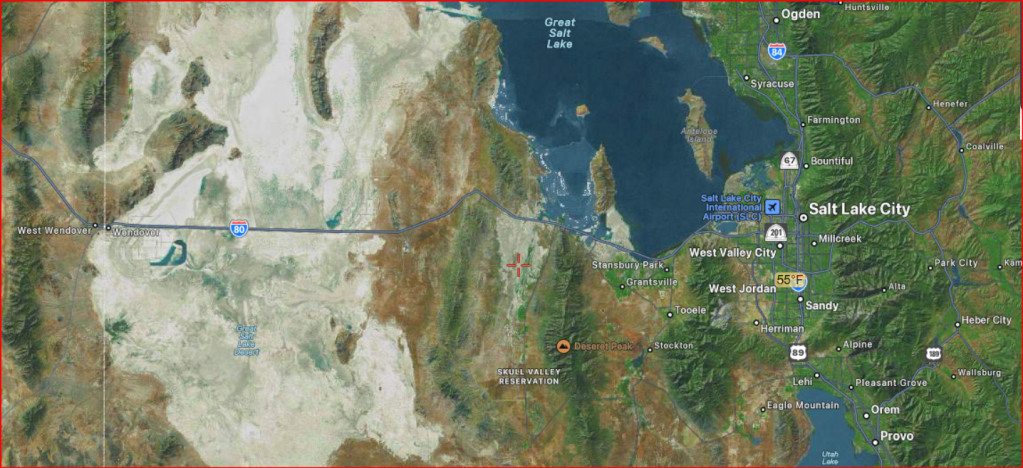- EnergySolutions Plans SMRs at Coal Site in Delta, UT
- Holtec Selects Utah for Its 300 MW SMRs
- New State Agreements put Utah at Heart of a Regional SMR Ecosystem
- Utah Signs MOU with the Idaho National Laboratory
Energy Solutions Plans SMRs at Coal Site in Delta, UT
IPA’s Delta, UT, coal-fired power plant. Image: IPA.
EnergySolutions said in a press statement it plans to develop one or more small modular reactors (SMRs) in collaboration with the Intermountain Power Agency IPA) and the State of Utah.
The agreement in the form of a nonbinding memorandum of understanding (MOU) calls for development of “advanced” nuclear power generation at a massive coal fired power plant in Delta, UT.
Key aspects of the project include:
- Partnering with IPA to leverage existing infrastructure at the IPP site.
- Potential development of advanced small modular reactor nuclear base load power.
- Potential synergy with the existing IPA energy hub and advanced grid stabilization technologies.
- Collaboration with local, state and regional stakeholders.
- Commitment to rural economic development and job creation in Utah.
The IPA is a power generating cooperative of 23 municipalities in Utah and six in California. The Delta, UT, power plant has two coal-fired units that produce 1,800 MW of electricity and is being phased out in favor of a new 840 MW natural gas-fueled plant.
EnergySolutions said the partnership with IPA could leverage existing infrastructure at the site for the new SMRs including grid connections and transportation access.
In terms of an “advanced” SMR in December 2024 Terrestrial Energy signed a memorandum of understanding to collaborate in building and deploying its Integral Molten Salt Reactor (IMSR) plants at sites owned by EnergySolutions. The IMSR as an advanced reactor has an advantage over other advanced designs in that it uses low enriched uranium fuel, e.g., <5% U235, and is not facing supply chain issues regarding access to HALEU fuel at 5-19% U2325.
Demand for Power for Utah Data Centers
A big chunk of Utah’s population is located along a booming high technology corridor that runs north to south along the western slopes of the Wasatch mountains. Demand for electricity to power its continued growth is one of the factors driving Utah’s interest in SMRs.
In March this year the Salt Lake City Tribune reported plans for massive construction of new data centers in the region. A Utah data center has secured a $2 billion investment — the second largest of its kind — to build the remainder of its West Jordan campus.
The newspaper reported that Novva’s 100-acre campus will be “one of the largest superclusters” of servers in the United States, said CEO Wes Swenson, powering 175 megawatts to data servers around the world.
Novva built the first stage of its Utah campus in 2020 and the $2 billion investment from JPMorgan Chase and Starwood Property Group will help the company finish the two remaining buildings.
It also is the second $2 billion loan awarded to a data center this year, according to reporting from The Wall Street Journal. Most data construction loans before January were less than $1 billion.
There are 39 data centers in Utah, according to the Data Center Map. Twenty-six of them are in the Salt Lake metro area.
About the EnergySolutions Site for Utah Nuclear Reactors
Utah’s desolate and mostly unpopulated vast Great Salt Lake desert west of Salt Lake City has been used for a variety of missions that could not be carried out anywhere else. Most of the vacant land in the region is owned and managed by the federal government.
Satellite view of Salt Lake City and western desert region. Image: Satellites Pro
If SMR developers want to locate their plants there it will add to the burden of site characterization related regulatory approvals. However, the feds have accepted placing high risk facilities there which is at arms’ length, at least an hour drive or more, from any of Utah’s major population centers.
Energy Solutions operates the Clive Disposal Facility which is located 75 miles west of Salt Lake City. EnergySolutions describes the site as having over 35 years of operational experience as a safe and compliant option for permanent disposal of radioactive waste.
The Clive disposal facility is permitted to accept mixed waste, which is a combination of both RCRA hazardous and radioactive waste. Treatment technologies include macro encapsulation of radioactive lead solids and hazardous debris, stabilization of heavy metals, neutralization and solidification of contaminated liquids, thermal treatment of waste containing organic solvents, amalgamation of elemental mercury, and treatment of other unique waste streams.
In 2012 The Army destroyed about 90% percent of its legacy chemical weapons at the Deseret Chemical Depot located 45 miles south west of Salt Lake City. It incinerated a large stockpile of now banned chemical weapons that had accumulated during the Cold War which officially ended in 1991.
The Army facility is not connected physically nor organizationally to the EnergySolutions Clive Disposal Facility.
& & &
Holtec Selects Utah for Its 300 MW SMRs
Jupiter, FL, based Holtec International announced it signed a strategic cooperation agreement with the State of Utah and Hi Tech Solutions, a leading nuclear services provider based in Kennewick, WA, to collaborate in the deployment of SMR-300s in Utah and the broader Mountain West region. Hi Tech will carry out the project development and workforce training to support the SMR effort.
While Holtec did not indicate it has any specific sites under consideration for its SMRs, the company’s plans so far have focused on building them at existing nuclear power stations. It has announced plans to build two units at the Palisades Nuclear plant in Michigan, which it is also working to restart. The firm is believed to be considering using the site of the decommissioned Oyster Creek reactor on the New Jersey Coast.
There are no nuclear reactors in Utah. The rocky mountain west is chock full of coal fired power plants which feature grid access, transportation infrastructure, and other factors that favor building new SMRs on them.
Holtec, in cooperation with Hi Tech Solutions, said its ambitions are to deploy a fleet of SMR-300 reactors across the Mountain West. To accomplish this goal, the firms said the companies will work to build a permanent training facility in Utah by 2028 to focus on operations, maintenance and future technologies. The training facility will focus on developing a skilled workforce for both the existing US reactor fleet and next-generation SMR technology through key collaborations with Utah’s Universities, technical colleges, and trade schools.
Holtec also announced it will develop a manufacturing site for its SMR-300 reactors to “strengthen the US nuclear supply chain by manufacturing and assembling SMR-related components and systems in Utah.”
Holtec’s President of Global Clean Energy Opportunities, Dr. Rick Springman, said in the firm’s press statement, “We are not just delivering nuclear reactors; we have put together a plan to deliver the entire nuclear ecosystem to Utah and the surrounding region, inclusive of EPC delivery of the plants, manufacturing centers to produce major components, and workforce development tied to the specific delivery needs for the program.”
Holtec added it has a plan for up to 4 GWs of SMR-300s deployed in the 2030s, primarily focused in Utah and Wyoming and supported by the ongoing testing at the Idaho National Laboratory. At 300 MW each, 4 GW of SMRs would be equal to more than a dozen of the PWR type units all of which will require significant amounts of water. Utah and Wyoming are characterized by vast stretches of desert terrain with little water to spare.
In a report on Holtec’s plans for Utah, Alexander Kaufman wrote in Latitude Media this week that the University of Utah has for 50 years operated a small test reactor, but it is used for researching medical isotopes, not producing electricity. Last fall, Governor Spencer Cox announced Operation Gigawatt, a strategy to double the state’s power generation over the next 10 years by “enhancing Utah’s policies to enable clean, reliable energy like nuclear and geothermal.”
Utah’s Ghosts of Nuclear Projects Past
Blue Castle Came Up Dry
Water rights are the “gold” needed to proceed with any energy project in Utah. A case in point is the experience of Aaron Tilton, a former Utah State Legislator, who was the project manager for the Blue Castle nuclear reactor project. In 2016 an extended battle over water rights sank the prospects of the proposed Blue Castle nuclear project which planned to develop twin Westinghouse 1,150 MW PWRs near Green River, UT.
Tilton said in 2016 the firm spent $20 million between 2008 and 2016. The firm ran out of money and lost its claims on the water rights it needed to proceed with the project.
In 2008 Blue Castle notified the NRC of its intent to apply for an Early Site Permit (ESP)/ The NRC said eight years later in 2016 that “the filing date is uncertain” for the project.” The NRC Adams library lists in its index ESP related filings by Blue Castle but no documents are listed for dates later than 2012.
Unsustainable Costs Crushed the UAMPS NuScale Project
Paradoxically, with all the excitement about nuclear energy in Utah, the one SMR developer which is not currently in the picture in Utah is NuScale. In November 2023 the firm called it quits for its plans to build a six-pack of its 77 MW SMR at the INL for its Utah based customer UAMPS.
Spooked by the rising costs, which elevated the eventual cost of electricity to be produced by the plant, the rate of new subscriptions as of January 2023 had stalled out and never met the required threshold of 80% of member firms to move forward to build the reactors.
UAMPS warned in January 2023 that costs for the NuScale project were heading into the stratosphere. The company said in 2021 it would deliver power for $58/MWh. By the start of 2023 that figure had climbed 53% to $89/MWh.
The estimated cost of the six SMRs rose from just over $5 billion to over $9 billion. In terms of rough order of magnitude numbers, that meant each of the six 77 MW SMR would cost $1.5 billion. Anyone doing the math could see this was not a sustainable financial future.
Utah Associated Municipal Power Systems (UAMPS) is a full-service agency that provides comprehensive wholesale electric energy services on a non-profit basis to community-owned power systems throughout the Intermountain West. The UAMPS membership represents 50 members from Utah, Arizona, California, Idaho, Nevada, New Mexico, and Wyoming.
& & &
New Agreements Place Utah at Heart of a Regional SMR Ecosystem
(WNN) The governors of Utah, Idaho, and Wyoming this week signed a cooperation agreement towards building a regional “energy corridor” defined by advanced nuclear technology. The agreement between Utah, Idaho and Wyoming was signed by the governors by Governors Spencer Cox (Utah), Brad Little (Idaho) and Mark Gordon (Wyoming).
It establishes a cooperative framework to align energy-related efforts across the three states, focusing on advancing energy resilience, coordinating infrastructure, advocating for common sense federal policies, and accelerating the development of “reliable, affordable” nuclear energy.
Under the agreement, the three states will collaborate in areas including aligning their energy policies to support innovation and private investment; coordinating the development of critical energy infrastructure; jointly navigating regulatory and environmental challenges; and advocating for federal support of regional energy priorities; as well as enhancing energy resilience and grid reliability and expanding workforce development efforts to support the growing energy sector.
Utah is emerging as a bee hive of ambitious nuclear energy projects all of which will take a decade or more of hard work to bring to reality. Holtec and Terrestrial Energy have MOUs to develop their SMR designs in the state.
Utah’s giant coal fired power plant at Delta, UT, is a major source of electricity for the City of Los Angeles making it a high profile example of California’s de facto policy of energy colonialism which pulls clean electricity from dirty (fossil fuel) power plants in other states. Eastern Utah and western Colorado are major uranium mining regions.
SMR developers plan to build multiple units of their designs to replace the 1,900 MW of generation capacity at the IPA plant. The utility has near term plans to build a gas-fired plant with 840 MW of power generation which is equal to about three of Holtec’s SMRs.
Idaho, home of the Department of Energy’ Idaho National Laboratory, is an energizer of outreach efforts to the three states in terms of providing access to R&D facilities, nuclear engineering expertise, and testing of micro-reactor designs. Several of them plan to build their advanced nuclear design prototypes there. Examples include commercial efforts by Oklo, Aalo, and DOD’s Project Pele. Others slated for testing at INL include Radiant and the Westinghouse eVinci micro-reactors.
In Wyoming TerraPower is developing its 345 MW Natrium advanced reactor which will replace a coal fired power plant. The firm says the first-of-a-kind plant will be the design basis for a fleet of them to be built for utilities in western states and for export.
Much of the power that is generated by the coal fired power plant in Kemmerer, WY, the TerraPower reactor is expected to replace is fed into the Utah power grid. Wyoming is a major supplier of uranium which is needed to fuel the nation’s nuclear reactors.
& & &
Utah Signs MOU with the Idaho National Laboratory
Utah leaders and Idaho National Laboratory (INL) this week signed a memorandum of understanding (MOU) to establish a formal, long-term collaboration on advanced energy research, workforce development and technology deployment—particularly on nuclear innovation.
The partnership will focus on key priority areas, including advanced nuclear energy technologies, infrastructure resilience, engineering and materials science, and data science applications for energy development.
The new MOU creates a structural, interdisciplinary alliance between Utah and INL—as the nation’s laboratory for nuclear energy research and innovation. The MOU envisions Utah establishing an Advanced Nuclear and Energy Institute as a key coordinating hub between INL, the Utah System of Higher Education, the Utah Office of Energy Development and the Utah San Rafael Energy Lab.
Through the Institute, Utah’s higher education institutions can collaboratively pursue and manage federally funded research grants, aligning projects with the specific strengths of each university and lab. Beyond academic research, the focus is on applied innovation—ensuring resources are used effectively to develop commercially viable, scalable technologies.
The INL said this approach “will accelerate the deployment of real-world energy solutions and help build a broader, more robust nuclear energy ecosystem in Utah and the surrounding region.”
Through this agreement, Utah and the INL will work together to:
- Accelerate the development and deployment of next-generation nuclear technologies
- Enhance scientific collaboration and research in critical energy sectors
- Strengthen cybersecurity and physical security for energy infrastructure
- Build the workforce needed to meet the demands of tomorrow’s energy economy
“This partnership will accelerate Utah’s efforts to become the nation’s nuclear hub,” said Governor Spencer J. Cox.
“By linking our universities, labs, and industry partners with the expertise of Idaho National Laboratory, we are strengthening our ability to serve Utahns with reliable and affordable energy.”
“As the Department of Energy’s nuclear energy laboratory, we’re excited to partner with Utah to address urgent energy needs by focusing on advanced nuclear and energy innovation,” said Idaho National Laboratory Director John Wagner.
“This partnership establishes a cooperative framework for scientific, technological and workforce development to help Utah realize an abundant, secure, resilient and competitive energy future.”
# # #









